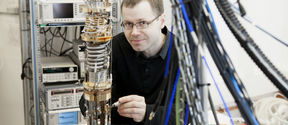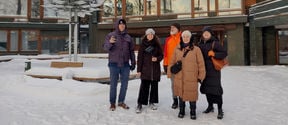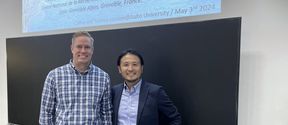The uncertainty principle, first introduced by Werner Heisenberg in the late 1920s, is a fundamental concept of quantum mechanics. In the quantum world, particles like the electrons that power all electrical product can also behave like waves. As a result, particles cannot have a well-defined position and momentum simultaneously. For instance, measuring the momentum of a particle leads to a disturbance of position, and therefore position cannot be precisely defined.
In recent research, published in Science, a team led by Professor Mika A. Sillanpää at Aalto University in Finland has shown that there is a way to get around the uncertainty principle. The team included Dr. Matt Woolley from the University of New South Wales in Australia, who developed the theoretical model for the experiment.
Instead of elementary particles, the team carried out the experiments using much larger objects: two vibrating drumheads one-fifth of the width of a human hair. The drumheads were carefully coerced into behaving quantum mechanically.
‘In our work, the drumheads exhibit a collective quantum motion. The drums vibrate in an opposite phase to each other, such that when one of them is in an end position of the vibration cycle, the other is in the opposite position at the same time. In this situation, the quantum uncertainty of the drums' motion is cancelled if the two drums are treated as one quantum-mechanical entity,’ explains the lead author of the study, Dr. Laure Mercier de Lépinay.
This means that the researchers were able to simultaneously measure the position and the momentum of the two drumheads – which should not be possible according to the Heisenberg uncertainty principle. Breaking the rule allows them to be able to characterise extremely weak forces driving the drumheads.
‘One of the drums responds to all the forces of the other drum in the opposing way, kind of with a negative mass,’ Sillanpää says.
‘In addition to providing a novel technique for evading limitations imposed by the uncertainty principle, this experiment provides the most direct demonstration of long-lived quantum entanglement between macroscopic objects,’ says Dr. Woolley.
Entangled objects cannot be described independently of each other, even though they may have an arbitrarily large spatial separation. Entanglement allows pairs of objects to behave in ways that contradict classical physics, and is the key resource behind emerging quantum technologies. A quantum computer can, for example, carry out the types of calculations needed to invent new medicines much faster than any supercomputer ever could.
In macroscopic objects, quantum effects like entanglement are very fragile and are easily destroyed by any disturbances from their surrounding environment. Therefore, the experiments were carried out at a very low temperature, only a hundredth of a degree above absolute zero at -273 degrees.
In the future, the research group will use these ideas in laboratory tests aiming at probing the interplay of quantum mechanics and gravity. The vibrating drumheads may also serve as interfaces for connecting nodes of large-scale, distributed quantum networks.
Sillanpää’s group is part of the national Centre of Excellence, Quantum Technology Finland (QTF). The research was carried out using OtaNano, a national open access research infrastructure providing state-of-the-art working environment for competitive research in nanoscience and technology, and in quantum technologies. OtaNano is hosted and operated by Aalto University and VTT.
The article Quantum mechanics–free subsystem with mechanical oscillators byLaure Mercier de Lépinay, Caspar F. Ockeloen-Korppi, Matthew J. Woolley, and Mika A. Sillanpää was published in Science 7 May.




